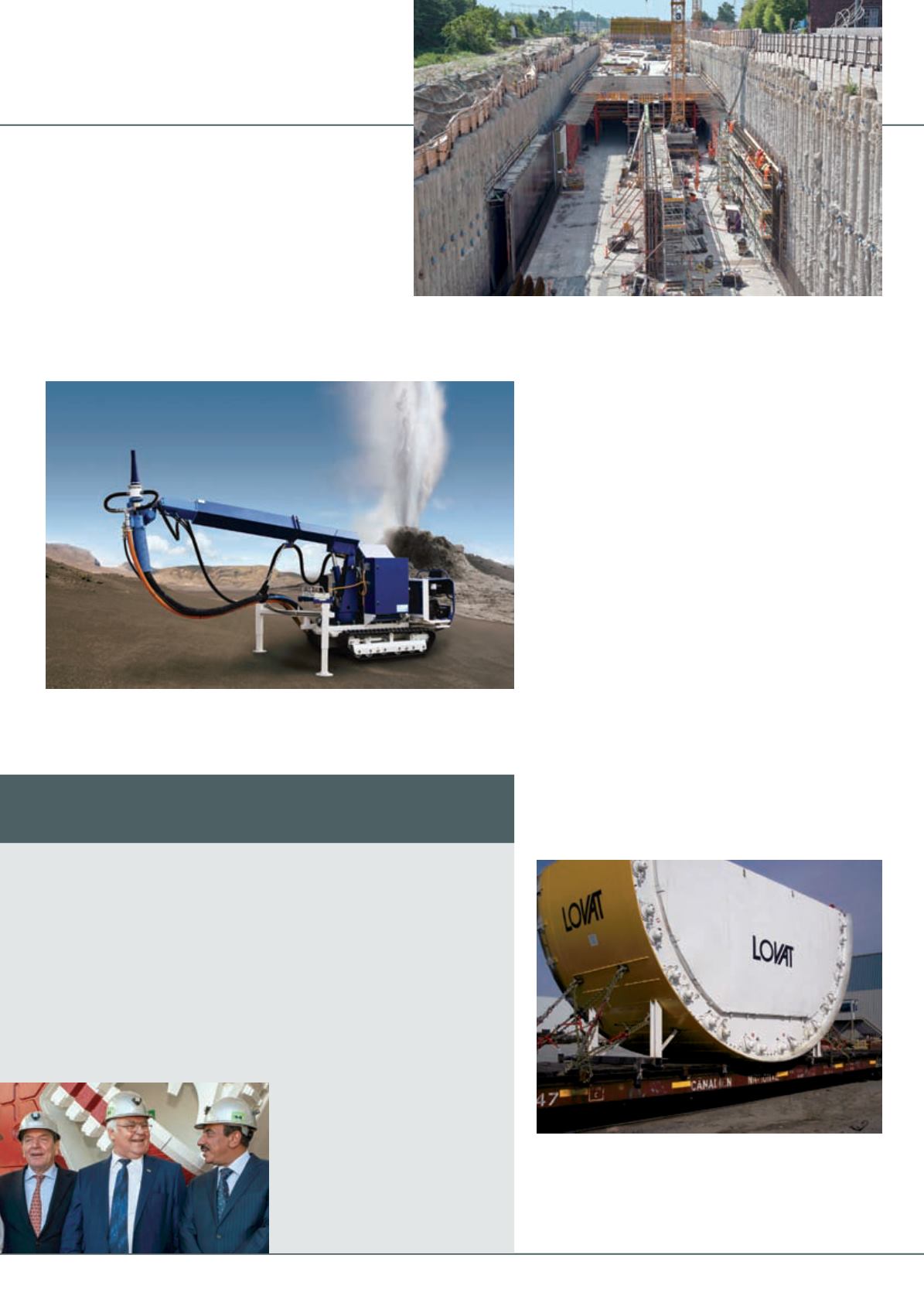
international
construction
april 2014
TUNNELLING
46
Unique challenges
backwards and forwards to handle up to 1,000 tunnel lining
segments.
Falsework& formwork
Meanwhile, several falsework and formworkmanufacturers have
added specialist tunnel formwork to their portfolio. Alsina, for
instance, offers a self-supporting formwork system that ismoved
by a hydraulically-driven carriage along a tunnel, allowing the
use of several formwork systems to line a tunnel.
Another method for tunnel building is Alsina’s Modular
Curved formwork for the construction of false tunnels and
tunnel entrances. This system supports a maximum pressure
of 60 kN/m
2
, requires a minimum bend radius of 2.5 m and
allows a modulation of 2.4 x 2.4m.This means it is adaptable
to different radii, while Alsina said it also facilitated quick and
securemounting, boosting productivity.
For its part, Doka used different techniques to support
construction of four tunnels during the building of the
€ 718 million (US$ 996 million), 22 km S 10 highway in the
Mühlviertel district of Austria.
These included itsmodular heavy-duty supporting systemSL-1
in combinationwith the large-area formworkTop 50 and high-
capacity hydraulics, and its new cut-and-cover tunnel formwork
system, Doka CC. This system supported construction of
both tubes of the Pernau Subsurface Tunnel, each of which is
270 m long. The formwork can be adapted to the complex,
slightly rotating geometry of the structure.
Doka CC also supported construction of the Ganglsiedlung
SubsurfaceTunnel,whichconsistsof two tubes, each275m long.
The manufacturer said adaptation to the structural geometry of
this tunnel required little additionalmaterial cost.
Ambitious
The tunnelling sector is busy and ambitious, with a range of
very large infrastructure projects currently underway around
the world. Of course it is ideal when everything runs smoothly
and projects are completed on schedule, but the sector’s ability
to overcome unforseen challenges like TBM breakdowns also
speaks volumes about the ability to solve problems.
iC
Qatar mega project
Work is ready to get underway on planned newmetro network
T
he first of 15Herrenknecht EPB TBMs has just been built and is ready to start work on
the newmetro network inDoha, Qatar. By 2019, they are planned to drive about 90 km
of tunnel through the limestone below theQatari capital for theRed Line South, theRed
LineNorth and theGreen Line.
Further plans envisage the completion of a second section of themetro by 2026. The
completed networkwill have four lines and around 100 stations, connecting the residential
and business centres of the capital with each other and the suburbs.
The first five EPB TBMswill be used to drive 34.7 km of 7m diameter tunnels through
limestone for theRed Line South. The contractor for this part of the project is a joint venture
betweenQatari Diar, Vinci ConstructionGrands Projects (QDVC), aswell as GS Engineering&
Construction andAl Darwish Engineering.
TheRed Linewill not only handle the bulk of the national transport and connect themost
important stadiums of the football World
Cup in 2022. As a central line it also
connects the city centrewith the airport and
theWestbay Central.
L to R, former German Chancellor
Gerhard Schröder, Herrenknecht
chairmanMartin Herrenknecht and
Qatari Transport Minister Jassim Saif
Ahmed Al Sulait.
The new 620m long Nordhavensvej road tunnel in Copenhagen, Denmark, is
being built using the cut-and-covermethod. Thewalls are concreted against the
up to 25m deep bore pilewall. Following this, the 80 cm slab is concreted using
Peri’s Variokit slab formwork carriage.
Eight Meyco Shotcreting units fromAtlas Copco are supporting construction of
the Tottenham Court Road underground station in London, UK. These include three
Suprema units for shotcrete pumping, three Oruga units (pictured) for general
sprayingworks, and two Piccola units for dry spraying.
Caterpillar is to sell the assets of Caterpillar Tunnelling
Canada Corporation to Chinese company Liaoning Censcience
Industry Co., Ltd. InMay last year, Caterpillar said it planned
to exit the sector and close the operation – formerly known
as Lovat, which it acquired in 2008. The new deal is expected
to close in the third quarter of 2014.


